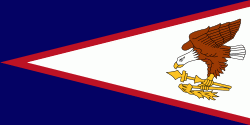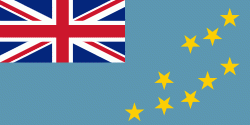Samoan language
Samoan (Gagana faa Sāmoa or Gagana Sāmoa; ) is a Polynesian language spoken by Samoans of the Samoan Islands. Administratively, the islands are split between the sovereign country of Samoa and the United States territory of American Samoa. It is an official language, alongside English, in both jurisdictions. It is widely spoken across the Pacific region, heavily so in New Zealand and also in Australia and the United States. Among the Polynesian languages, Samoan is the most widely spoken by number of native speakers.
Samoan is spoken by approximately 260,000 people in the archipelago and with many Samoans living in diaspora in a number of countries, the total number of speakers worldwide was estimated at 510,000 in 2015. It is the third-most widely spoken language in New Zealand, where 2.2% of the population, 101,900 people, were able to speak it as of 2018.
The language is notable for the phonological differences between formal and informal speech as well as a ceremonial form used in Samoan oratory.
Samoan is an analytic, isolating language and a member of the Austronesian family, and more specifically the Samoic branch of the Polynesian subphylum. It is closely related to other Polynesian languages with many shared cognate words such as aliʻi, ʻava, atua, tapu and numerals as well as in the name of gods in mythology.
Linguists differ somewhat on the way they classify Samoan in relation to the other Polynesian languages. The "traditional" classification, based on shared innovations in grammar and vocabulary, places Samoan with Tokelauan, the Polynesian outlier languages and the languages of Eastern Polynesia, which include Rapanui, Māori, Tahitian and Hawaiian. Nuclear Polynesian and Tongic (the languages of Tonga and Niue) are the major subdivisions of Polynesian under this analysis. A revision by Marck reinterpreted the relationships among Samoan and the outlier languages. In 2008 an analysis, of basic vocabulary only, from the Austronesian Basic Vocabulary Database is contradictory in that while in part it suggests that Tongan and Samoan form a subgroup, the old subgroups Tongic and Nuclear Polynesian are still included in the classification search of the database itself.
Samoan is spoken by approximately 260,000 people in the archipelago and with many Samoans living in diaspora in a number of countries, the total number of speakers worldwide was estimated at 510,000 in 2015. It is the third-most widely spoken language in New Zealand, where 2.2% of the population, 101,900 people, were able to speak it as of 2018.
The language is notable for the phonological differences between formal and informal speech as well as a ceremonial form used in Samoan oratory.
Samoan is an analytic, isolating language and a member of the Austronesian family, and more specifically the Samoic branch of the Polynesian subphylum. It is closely related to other Polynesian languages with many shared cognate words such as aliʻi, ʻava, atua, tapu and numerals as well as in the name of gods in mythology.
Linguists differ somewhat on the way they classify Samoan in relation to the other Polynesian languages. The "traditional" classification, based on shared innovations in grammar and vocabulary, places Samoan with Tokelauan, the Polynesian outlier languages and the languages of Eastern Polynesia, which include Rapanui, Māori, Tahitian and Hawaiian. Nuclear Polynesian and Tongic (the languages of Tonga and Niue) are the major subdivisions of Polynesian under this analysis. A revision by Marck reinterpreted the relationships among Samoan and the outlier languages. In 2008 an analysis, of basic vocabulary only, from the Austronesian Basic Vocabulary Database is contradictory in that while in part it suggests that Tongan and Samoan form a subgroup, the old subgroups Tongic and Nuclear Polynesian are still included in the classification search of the database itself.
Country
-
American Samoa
American Samoa (Amerika Sāmoa, ; also Amelika Sāmoa or Sāmoa Amelika) is an unincorporated territory of the United States located in the South Pacific Ocean, southeast of the island country of Samoa. Centered on -14.3°N, -170.7°W, it is east of the International Date Line and the Wallis and Futuna Islands, west of the Cook Islands, north of Tonga, and some 500 km south of Tokelau. American Samoa is the southernmost territory of the United States and one of two U.S. territories south of the Equator, along with the uninhabited Jarvis Island.
American Samoa consists of five main islands and two coral atolls; the largest and most populous island is Tutuila, with the Manuʻa Islands, Rose Atoll and Swains Island also included in the territory. All islands except for Swains Island are part of the Samoan Islands, The total land area is 199 sqkm, slightly more than Washington, D.C. As of 2022, the population of American Samoa is approximately 45,443 people, of whom the vast majority are indigenous ethnic Samoans. Most American Samoans are bilingual and can speak English and Samoan fluently. -
Samoan Islands
The Samoan Islands (Motu o Sāmoa) are an archipelago covering 3030 km² in the central South Pacific, forming part of Polynesia and of the wider region of Oceania. Administratively, the archipelago comprises all of the Independent State of Samoa and most of American Samoa (apart from Swains Island, which is geographically part of the Tokelau Islands). The land masses of the two Samoan jurisdictions are separated by 64 km of ocean at their closest points.
The population of the Samoan Islands is approximately 250,000. The inhabitants have in common the Samoan language, a culture known as fa'a Samoa, and an indigenous form of governance called fa'amatai. Samoans are one of the largest Polynesian populations in the world, and most are of exclusively Samoan ancestry. -
Tuvalu
Tuvalu ( or ; formerly known as the Ellice Islands) is an island country and microstate in the Polynesian subregion of Oceania in the Pacific Ocean. Its islands are situated about midway between Hawaii and Australia. They lie east-northeast of the Santa Cruz Islands (which belong to the Solomon Islands), northeast of Vanuatu, southeast of Nauru, south of Kiribati, west of Tokelau, northwest of Samoa and Wallis and Futuna, and north of Fiji. Tuvalu is composed of three reef islands and six atolls. They are spread out between the latitude of 5° and 10° south and between the longitude of 176° and 180°. They lie west of the International Date Line. Tuvalu has a population of 11,204 (2021 world bank). The total land area of the islands of Tuvalu is 26 km2.
The first inhabitants of Tuvalu were Polynesians, according to well-established theories regarding a migration of Polynesians into the Pacific that began about three thousand years ago. Long before European contact with the Pacific islands, Polynesians frequently voyaged by canoe between the islands. Polynesian navigation skills enabled them to make elaborately planned journeys in either double-hulled sailing canoes or outrigger canoes. Scholars believe that the Polynesians spread out from Samoa and Tonga into the Tuvaluan atolls, which then served as a stepping stone for further migration into the Polynesian outliers in Melanesia and Micronesia.
